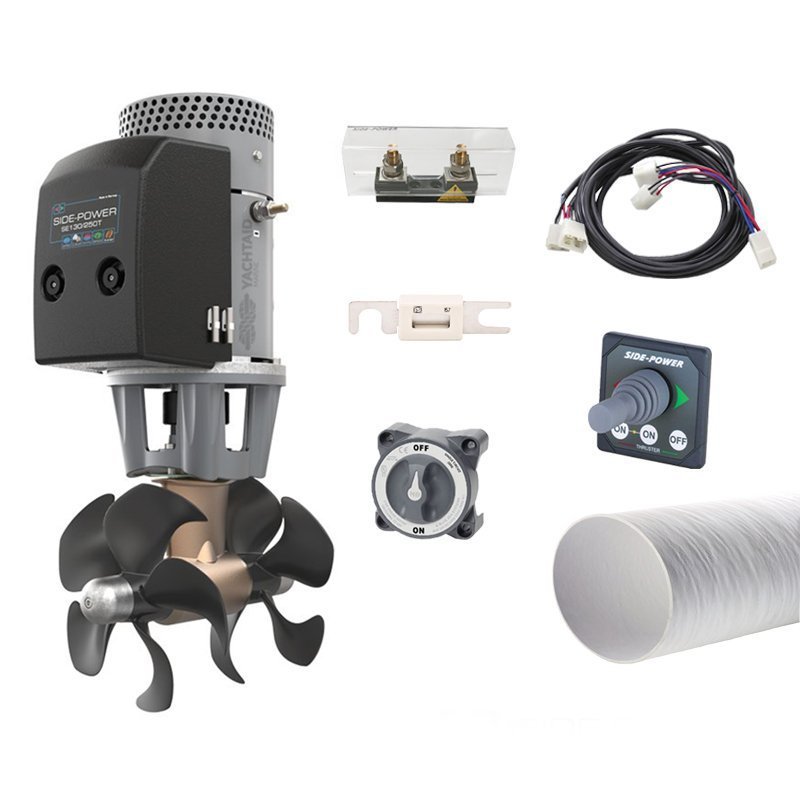Thrusters: what there is to know?
Thruster systems (also called maneuvering systems) in leisure boats are often associated with large and expensive yachts. This is because there’s still a false stereotype out there, that these systems are extremely expensive and hard to install. In fact, it’s the opposite!
Today, most thruster manufacturers can offer solutions that would fit pretty much any, even the smallest boat. You only need to have space to install at least a 110mm thruster tunnel, which can be installed almost in any boat that has a rigid hull. Furthermore, such small systems now became even more affordable than before – you now can buy a full thruster system, that would be sufficient for boats up to 7m long, for less than 1000 Euros (excluding VAT)! So what exactly is there to know, when selecting such a system?
Firstly – there’s thrust and size. There are loads of thruster systems out there and they all differ in power, size and without doubt – price. The main criteria when selecting one is thrust, which is stated in Kilogram-force, or KGF in short. It’s the KGFs, not Kilowatts that are the true measure of thruster’s usefulness. We often get inquiries from customers, who ask for i.e. a 3kW thruster. But little do they know is that those 3kW of electrical power may generate anything from 45kgf to 70kgf. It all depends on the propeller, it’s size, shape and hydrodynamic characteristics. It’s a common practice that thrust is boat size dependent – the larger the boat, the more thrust you need. As simple as that.
However, before we go any deeper, there is one trick, which many thruster manufacturers use when declaring their thrust properties, that needs to be disclosed: most declare their thrust at 12V (or 24V) voltage. Unfortunately, due to the nature of how and when these thrusters are used, at that very moment, when you will use your system, there won’t be any 12V (or 24V) in it. You’ll have 11.5V at best, but most likely even 11V. So, what’s that got to do with you? Well, if you calculate that you need 60kgf of thrust for your boat and you buy one that gives out 60kgf at 12V, in real life you will never have that power. Based on the example above you’re lucky if you’ll get 55kgf of thrust out of it. Which means that your device will not be suitable for your boat. And what’s the point of having a device, which will not perform as expected? To avoid such situation, you have to choose your thruster output, declared at 11V or better yet – 10.5V. This way you’ll be sure to have the correct thrust when you need it most.
Next, as in most cases – size does matter. At least, partially. You see, the thruster tunnel has to be mounted as closer to the bow or stern as possible. When it comes to bow thruster installation, most boats have their keel formed to point upwards. So if you want to install your thruster correctly (submersed under water by at least it’s own size and be above the bottom of the keel by at least a quarter of it’s size) you often run out of required space and may be forced to shift the tunnel slightly backwards. There’s a clever way to overcome this issue – try shopping around and searching for a thruster, that uses the same tunnel size, but packs more punch. Often, industry leading manufacturers offer systems that are more efficient than their competitor’s, so you can end up by having the same thrust packed in the same or even slightly smaller tunnel. Let’s not forget that a smaller tunnel installed closer to the bow will be more efficient than a larger tunnel installed further from it!
The third and often neglected criteria, when selecting a thruster system is its usage interval. Most simple thruster systems operate as so called “on/off” type devices: you press the button or move your joystick and instantly hear that typical thruster growl as your thruster mashes that water with its full power. Unfortunately, it may not do this forever. Most devices have a safe runtime of 30s, after which these devices may start to overheat. Such runtime is usually enough, but if you come across heavy side winds or currents and you need to keep your boat still for a longer time, you may find that those 30s are not enough. Luckily there’s a solution for that. Not many do know that nowadays there are so called proportional thrusters, which have virtually unlimited runtime. Their power can be distributed, as the name suggests, proportionally. Imagine buying an extremely powerful system, because you occasionally may find yourself docking in excessive wind or current. However, such system would not be capable of smooth docking during those frequent good weather no wind days – as soon as you touch that control, your boat will be thrown sideways like a potato in a bucket. This is because under normal circumstances your system is overpowered. This is not a problem when using proportional type thrusters, because they allow you to adjust your thruster’s power output according to your needs. When compared to regular on/off type thrusters, the proportional once don’t have any drawbacks at all (well, maybe just a slightly more expensive initial price). They work much more quietly (as certain circumstances they may not be heard at all), smoother, often their control panels have integrated temperature and battery power indicators, but most importantly – they have a virtually unlimited runtime. All specialists claim the same – if you can afford it – go proportional!
One final thing, which needs to be considered before buying a thruster system is its power source. If your boat doesn’t have a lot of hydraulics on board, most likely you’ll go for a DC type thruster system. In such case, you need to think of its batteries, charge and the space to install everything. It is recommended to choose at least AGM type batteries, which can be fully depleted without any consequences (regular lead batteries will be soon damaged if used in such conditions). Don’t forget to select the battery according to your system’s minimum requirements and desired runtime. As an example, a small 20kgf thruster, mounted in a 6m boat, will require at least 150A of power. To provide such momentum, a battery must be rated at least at 300A CCA (cold crank amps). A small 40-50 Ah capacity battery usually will have just that. So, you can go ahead and select the capacity you need – smaller capacity – less runtime, but also smaller charger required for recharging. The later needs to have an output of at least 10% of the battery capacity. If you go for less than that, you not only will prolong your charge time, but in some cases may even damage your expensive batteries. Another highly recommended addition to your electrical system is even a simplest battery monitor. Not only will it help to monitor your battery’s life, but also will make sure that you have enough power when you need it.
As you see, a thruster system isn’t that complicated, however when selected incorrectly – it will sure make more trouble than good. Therefore, it is very important to select the correct components and to build a system based on your needs.
Contact your nearest BMG Power Systems branch and we’ll make be happy to offer you a best possible option!


